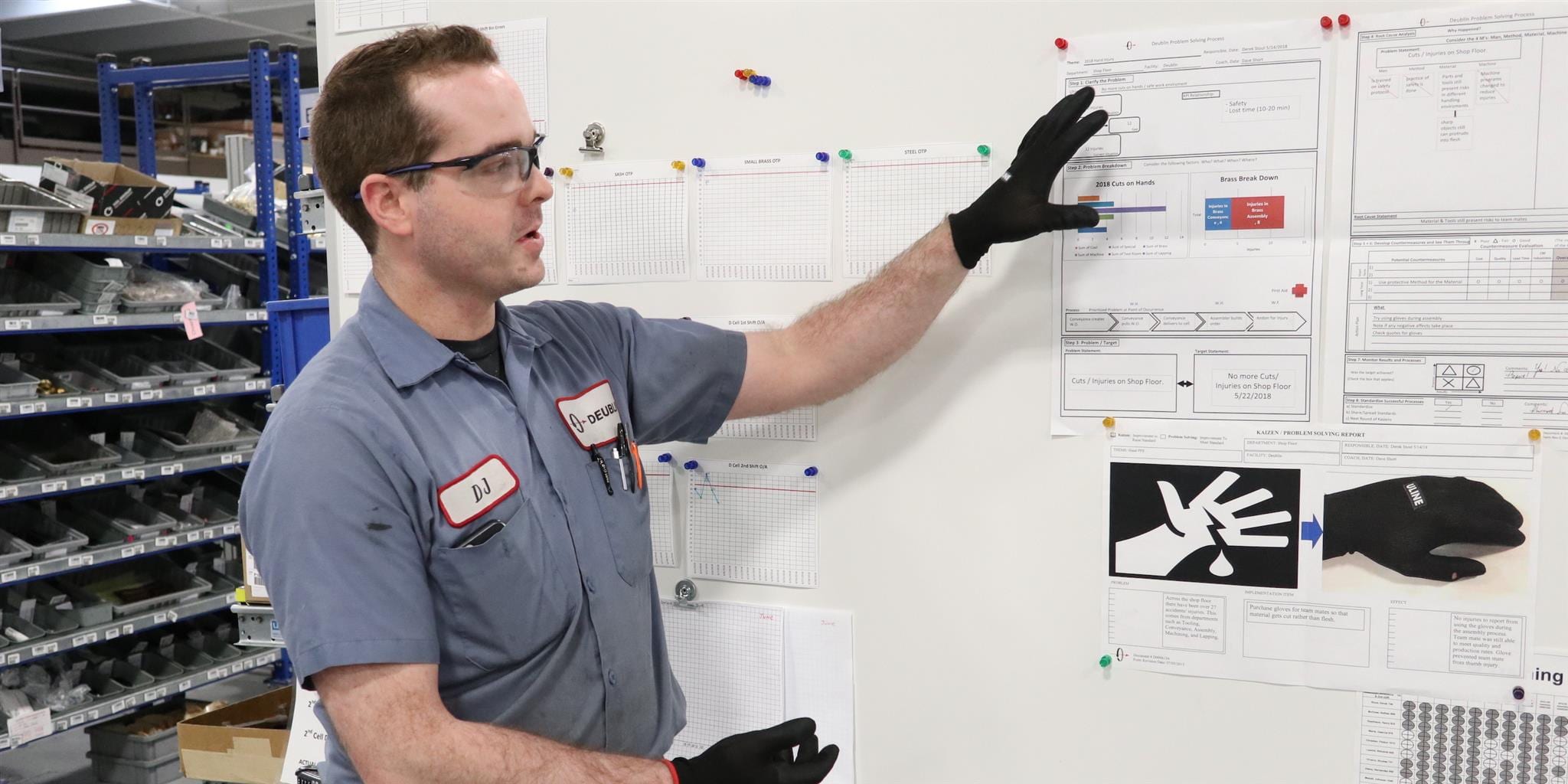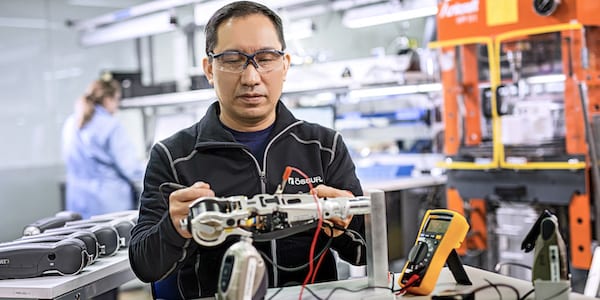
The architecture of a lean transformation
FEATURE – The role of the coach in a lean transformation is an often-debated topic. The author discusses his experience building the architecture of the Halfway turnaround.
Words: David Brunt, CEO, Lean Enterprise Academy – United Kingdom
You may have seen the articles and the video documentary on the Halfway story here on Planet Lean. Most are written by the people working in the sites, departments or teams at the Halfway group. I like to think that Planet Lean is for them, to inspire people like them to develop and share their stories – it’s very powerful.
This article is a little different. It’s the hidden story of what Terry O’Donoghue and I have been doing and how we have been helping people do the amazing things you have been reading about. The reflections we have at the end of each day at the gemba and the learning we’ve had are extremely valuable to us, so I thought it would be worthwhile to write down – and perhaps try to codify – our activities. Our hope is that this will be useful to the wider lean community and to others trying to achieve a lean transformation.
First, what do I mean by “architecture”? I am not talking about designing a new building (even though this year, for the first time, we have done just that for the sales and service teams), but about “the structure or design of anything complex or the carefully designed structure of something.”
With this in mind, the architect is the person responsible for inventing or realizing a particular idea or project. Once you have understood you need an architect, an obvious question to ask is “who is best to be the lean architect?” Obviously a leader! In the Halfway case, Terry O’Donoghue has taken that role. Unfortunately, (unlike Terry, who is a 30-year Toyota veteran) most people rarely have the know-how to do this, nor the inclination.
So, if a leader wants to do this (quickly), they need help from someone with lean knowledge. But – buyer beware! – this doesn’t mean that the person with lean knowledge can do this for you. The target condition should be for an organization to be able to do this lean stuff for themselves! This is about lean thinking. Therefore, the architect can help you define the problem to solve (or, more often than not, problems) and teach and coach “as little as possible, as much as necessary”. The acid test is whether the organization and its people are able to think lean for themselves. And whether your help comes from outside or inside the organization, this target condition is something you can never lose sight of.
At Halfway, even though we started on the gemba in the service and repair workshop, Terry and I talked firstly about why the organization would need (not want) to do this. I learned that Halfway (like any organization) had lots of problems. There are some industry specific issues, such as the declining margins in new cars or the lower amounts of servicing vehicles need these days, and there are some specific Halfway issues, one of the biggest being the age profile of the senior team and how to develop the next generation of managers.
When you’re surrounded by problems it’s difficult to see a path, so let’s look at how a lean thinker should approach the situation. Terry and I started by asking questions related to customer purpose and organizational purpose, and then iterated and iterated until we got a short, sharp statement.
As far as Customer Purpose is concerned, this is what we came up with:
“What do our customers want?”
Hassle-free mobility: 100% right first time, on time – in the sites where lean thinking has taken hold purpose is translated for that site.
“How well do we currently deliver value to our customers?”
Poorly! In 2012 RFTOT (Right First Time On Time, our measure given our purpose) wasn’t measured (it was around 30%-40% in the best cases).
“If you were able to deliver value, what could we really do, how much could we grow?”
Don’t know, but no one does this – perhaps a lot!
In terms of Organisational Purpose, we got to this:
“What does our organization need to survive and even to prosper?”
We need to give customers what they need, cover our costs (even make money) through aftersales, and capture a larger proportion of the customer’s motoring spend. Most importantly, we need to develop people to be able to do all of this!
“Are our initiatives aligned to providing the most value from the customers’ perspective whilst consuming the fewest resources?”
Not really! The problem(s) at the top of the agenda for the leadership team weren’t those that needed to be at the top of the agenda if we were use lean thinking to transform Halfway.
This last point appears frequently in my reflections of the different businesses I go and see: the problems top management highlights don’t correspond to those that naturally lead us to the realization that we need to pursue lean thinking in the organization. This is a critical issue, but it gets worse than that. Over the last 25 years, the term “lean thinking” has become a catchall. There are now several “flavors” to lean. So, in many cases people think they are doing lean, but I’d argue that they they’re not really. When this happens, they then focus on what they can do, rather than on what they need to do.
Throughout this process, we wanted to stay true to the original principles and concepts laid down in Lean Thinking and The Toyota Way. This meant constantly checking that we were defining value from the customer’s perspective, defining the problems to solve, focusing on the work to be done and establishing a management system and leadership behaviors to support the improvement of the work and the development of capabilities (including our own). Sadly, this focus doesn’t appear in the attempts of many organizations to implement lean – many of us will be aware of tools-based approaches, programs to implement specific aspects of what people understand as lean, certification – of individuals or firms – or even the desire of many companies to roll out best practices.
At Halfway, to stay on track, we often asked whether our efforts were still focused on how well we were delivering value to customers, how much of our time was focused on value (quality, delivery and cost vs pure cost-saving initiatives), and how well our activities linked to customer and business purpose.
Our focus – which is one of the main factors contributing to the success of the Halfway transformation – was on three elements:
- Strategy (purpose)
- Sites – to define key problems.
- The front line – to develop problem solving capability in each manager and worker on the sites we worked with.
Let’s take a look at these in more detail.
The team defined the problem to be solved – Halfway’s customer purpose – as guaranteeing hassle-free mobility, with 100% customer fulfilment (right first time, on time), an unmatched customer experience and developing experience in niche market offerings.
They then fleshed out the other questions we posed – about the process and the people elements – to highlight the capabilities we would need to develop to complete the work and meet the customer purpose.
At the site level, we developed visuals linked to purpose. We drew value streams to see flow and carried out hands-on experiments – learning experiences to help people to improve the work while at the same time developing their capability.
And we did this without a roll-out! I believe roll-outs are linked to traditional thinking. When something works, it is normal to wonder how we can replicate the same success elsewhere. There are, however, a number of issues with this way of thinking. First of all, it is impossible to be sure that the countermeasures that have been applied in one place will actually work in another. Secondly (and probably most importantly), giving people an answer robs them of the opportunity to think through their problems and develop themselves. What typically happens in a roll-out is that you spend more time convincing people of the potential solution rather than developing their problem-solving capabilities. At Halfway, instead of a roll-out, we decided to conduct experiments in the same way as we would use set-based design: having people look at problems in parallel and develop countermeasures. By sharing a process (and not just the countermeasures used to try and fix it), teams and individuals learn faster and more deeply. Under our method, people on a site identify a problem, develop a hypothesis, and design an experiment. But not just any experiment. They come up with an experiment aligned to lean principles – always thinking in terms of customer value, one-piece flow, pull, standardized work and improvement by people closest to the work and taking an end-to-end perspective. Critically, they share with their colleagues both the process they undertook and the results they achieved.
Doing improvement this way means to ensure that our processes meet our purpose. Value flows to the customer, and a clear customer purpose makes it easier for us to align people to develop simple, but meaningful kaizen. I believe this clarity of purpose comes across in all the articles we have published so far:
- PL's first-ever documentary offered an overview of the Halfway transformation. Watch it here.
- How lean thinking applies to sales at Halfway Ottery. Read more here.
- Read this article to learn how Halfway Ngami revolutionized car servicing and repairs.
- The amazing 14-month turnaround of a car preparation center in Johannesburg. Read more here.
- The "cash-to-cash" model at Halfway Ottery. Learn about it here.
- How visual management supports Halfway Ottery's Finance Department. Read about it here.
- The leadership view: the Principal of Halfway Ottery shares his experience with lean here.
- Every person counts: how lean thinking transformed Halfway Ngami. Read more here.
I believe this is a very different approach to what I see most organizations implement. At Halfway, we are trying to develop people by applying principles, not tools. We are using lean principles to develop one person at a time based on pull, rather than pushing concepts and ideas at them. We are creating processes that enable them to learn to think for themselves. Along the way, we are transforming the whole business.
Here’s one last thought. People will ask whether this is a sustainable approach – a popular question these days – and my current view is that it isn’t, unless you stick to it. Results will be sustained only if leaders and front-line employees continue to develop their thinking. Lean thinking is fragile, but if done right it represents an extraordinary competitive advantage. As we often say, it is a journey – one that can be fun if it’s done with the right intent. Every now and then, you also get to play architect to help support the creation of a great example and develop wonderful lean thinkers at the same time. And that’s what makes it all worthwhile.
THE AUTHOR

Read more


WOMACK’S YOKOTEN – The author visits a company that has sustained lean for a decade. In trying to understand how they did it, he finds how fundamentally the management system has changed.


CASE STUDY - Össur is recognized as a leader in the fields of prosthetic, osteoarthritis and injury solutions, but how did lean management and a trial-and-error approach to improvement help it to stay competitive?


FEATURE – Too often we tend to focus on trying to replicate success, rather than analyze failure. Yet, learning from mistakes is a fundamental principle in lean. This account of a transformation gone south offers an insightful critique of lean.


FEATURE – Only when we go where the action is, do we begin to truly understand the work. Rose Heathcote joins the Emergency Medical Services in Cape Town for a day.

